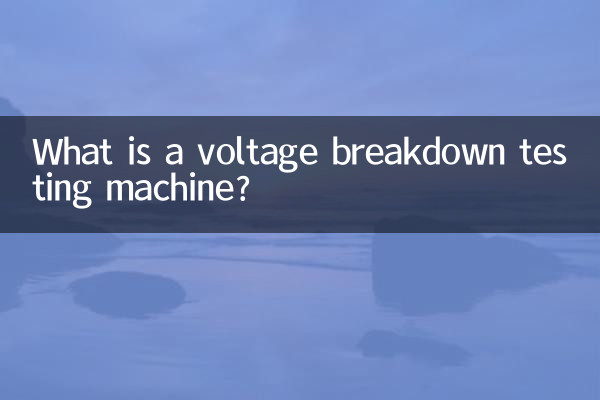What is a voltage breakdown testing machine?
The voltage breakdown testing machine is a professional equipment used to test the insulation properties of materials. It is widely used in fields such as electricity, electronics, and materials science. It detects the breakdown voltage value of the material by applying high voltage to evaluate its dielectric strength and voltage resistance. This article will introduce in detail the principle, application scenarios, technical parameters and popular models of the voltage breakdown testing machine.
1. Working principle of voltage breakdown testing machine

The voltage breakdown testing machine gradually increases the voltage until the material under test breaks down, and records the voltage value at this time as the breakdown voltage. During the test, the equipment monitors current changes to ensure the safety and accuracy of the test. Here’s how it works at its core:
| steps | Description |
| 1. Sample preparation | Make the material to be tested into a specimen of standard size to ensure that the surface is clean and free of contamination. |
| 2. Voltage application | The voltage is increased at a constant rate or in steps until breakdown occurs. |
| 3. Data recording | Record the breakdown voltage value, current curve and environmental parameters (such as temperature, humidity). |
| 4. Result analysis | Determine whether the insulation performance of the material meets the standards through software or manually. |
2. Application fields of voltage breakdown testing machine
Voltage breakdown testing machines play an important role in multiple industries. The following are its main application scenarios:
| Industry | Specific applications |
| Electrical equipment | Test the voltage resistance performance of transformers, cables and insulators. |
| Electronic components | Evaluate the dielectric strength of materials such as capacitors and circuit boards. |
| Materials Science | Investigate the electrical properties of new insulating materials such as nanocomposites. |
| Automobile industry | Test the safety of high-voltage components of new energy vehicles. |
3. Technical parameters of voltage breakdown testing machine
Different models of voltage breakdown testing machines have differences in performance. The following is a comparison of common technical parameters:
| parameters | range | Description |
| Output voltage | 0-100kV | Choose different ranges according to test requirements. |
| Boost rate | 0.1-5kV/s | Adjustable, affecting test accuracy. |
| Test accuracy | ±1% | High-precision equipment can reach ±0.5%. |
| Security protection | Overcurrent, overvoltage, short circuit protection | Ensure operator and equipment safety. |
4. Recommended models of recently popular voltage breakdown testing machines
According to market research in the past 10 days, the following models have received widespread attention due to their stable performance and high cost performance:
| Model | brand | Features |
| BDJC-50 | Beijing Beiguang | 50kV output, automatic voltage boost, supports multiple international standards. |
| HCDJ-100 | CTI Instruments | 100kV high voltage, with touch screen control, easy to export data. |
| ZJC-20 | Zhongke Testing | 20kV portable design, suitable for field testing. |
5. Future development trends of voltage breakdown testing machines
With the advancement of new materials and smart technology, voltage breakdown testing machines are developing in the following directions:
1.Intelligent: Integrate AI algorithms to achieve automatic diagnosis and data analysis.
2.High precision: Improve the measurement accuracy to ±0.1% to meet the needs of scientific research.
3.Environmentally friendly design: Reduce energy consumption and use non-polluting materials.
4.Multifunctional integration: Combined with functions such as dielectric constant testing and partial discharge detection.
In summary, voltage breakdown testing machines are key equipment for ensuring power safety and material research and development, and their technological upgrades will promote the further development of related industries.

check the details

check the details